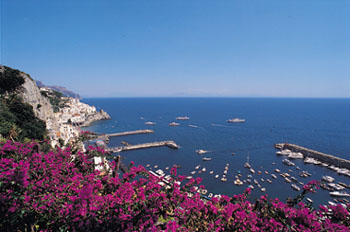Amalfi
History
City Tour Appointments
Specialitys
|
There is no fixed
season to visit the Amalfitan Coast: every day is right one, each with its own
colours...
flower filled towns, blue mountains, tall castles and ancient abbeys...and
always the sea: from precious emerald to pale turquoise...and the coast of rocks
and sand...yuo choose: every minute is yuors and nobody elses...
|

|
"The
day of Universal Judgement for the people of Amalfi who go to Paradise will be a
day just like any other..." RENATO
FUCINI
|
|
To introduce Amalfi to the distracted tourist who seeks only hurried sensations
and momentary beauty , a tourist hand-out or a documentary sequence would
suffice .... To penetrate the millenary soul of Amalfi, that magnificent
combination of nature, art and tradition that makes her unique is another thing
altogether; only the heart can guide us....
|
|
|
|
Grand
events on the coast of Amalfi, crossroads between East and West, a
memory of power and glory, of blood and chains, of cultures that
admired, encountered and finally united; on the facades of the
Churches, in the features of her people.... Now for you, the places
and dates, the battles and ceremonies...
|
|
The name is said to come from Hercules who wanted to make the
magnificent beach the last resting place of the graceful Amalfi, a
nymph with eyes the colour of the sea... but perhaps it is only a
legend in the classical manner, and it was probably the practical
inhabitants of Scala who founded it in the VI century...
|
|
Independent State from 839 to 1096 A.D. it was the major commercial
and military power in the high Tyrrhene, the Maritime Republic of
Amalfi, united under the shield of silver with a red band an ample
territory that included Gragnano, Agerola, Lettere and Tramonti inland.
Cetara and Positano on the coast and the isle of Capri with all the
adjacent sea, calling Amalfitan all those who where within these
boundaries. Joined together in political and military relations, for
internal matters every "Universitas " kept its name and had
ample administrative autonomy but also a specific role at the service
of sister cities. A centre of production and a well equipped goods
wharf , Amalfi was Capital and also the Archbishop's seat and
of the central government at whose head succeeded Prefects,
Comites and Judges, until Mastalo II in 954 A.D. established the
Dukedom...
|
|
Between the XI and XII centuries at the height of her power the ships
of Amalfi covered the sea from North Africa to the coasts of Syria and
Palestine, as far as Asia Minor , establishing embassies and
warehouses: in Alexandria of Egypt, in Tunis and Byzantium, at
Jerusalem it opened a large hospital with a capacity of 1.000 beds,
run by the friars "Ospedalieri di S: Giovanni "(later to
become Order of the Cavaliers of Malta)...
|
|
In all these territories, the Tarì of Amalfi made of gold or
bronze was legal tender. The "Tabulae Amalphitanae "
, a nautical chart with the rules of navigation was used and also the
Chinese compass and the Egyptian Astrolabio ; instruments practically
unknown in the West ...The building style "Romanesque-Amalfitan
" was born that added to the rigour of the western
Romanesque style, elements of the Moorish and Byzantine culture...
|
|
The end of the XII century saw the decline , it was Guiscardo who set
the law in the South of Italy, and the attempts of Amalfi to liberate
herself caused the definite deposition of the Duke (1096)...This
allowed the city of Pisa to sack the coast in1135 and (again in 1137)
destroying every hope of a revival. Laid waste and defeated, with the
hereditary feuds in the hands of rulers who came and went, Amalfi and
her coast was reduced to a low level , small towns survived only
because of agriculture and modest manufacturing activities: paper,
woollen cloth and leather tanning... In the XVII and XVIII centuries
producing pasta and lemons until the middle of the XIX century...
|
|
In the wake of romanticism and the Grand Tour, attracted by the wild,
untouched nature and the local customs, and also the myths of Masaniello
and Giovanna of Aragon, German and English Travellers
discovered the coast and brought it a new lease of life...
|
|
The cultural avantgarde of those early times leads us to the
appointment with the sixties, the years of the economic boom and the
"Dolce Vita" (Sweet Life), that in the Summer
bivouacs between Capri, Positano and Amalfi, actors ,producers,
artists and adventurers people the Amalfi coast: love-affairs are born
and also works of art...
|
|
In the footsteps of the V.I.P. there was an explosion of mass-tourism:
a dream available for all...
|

|
